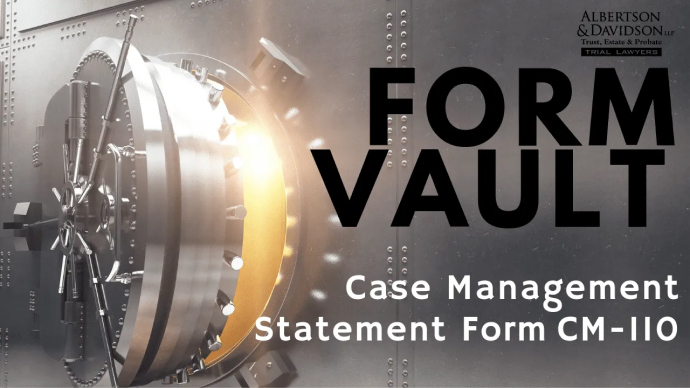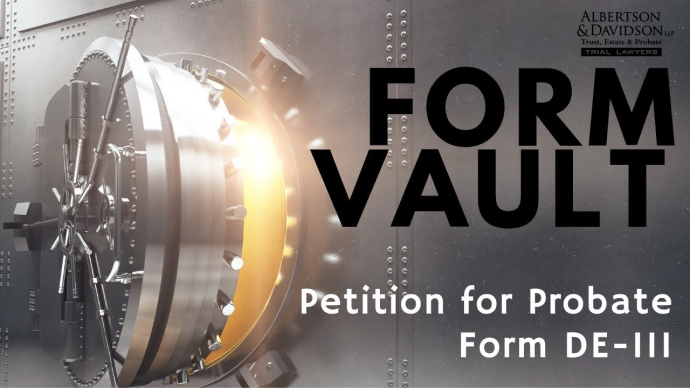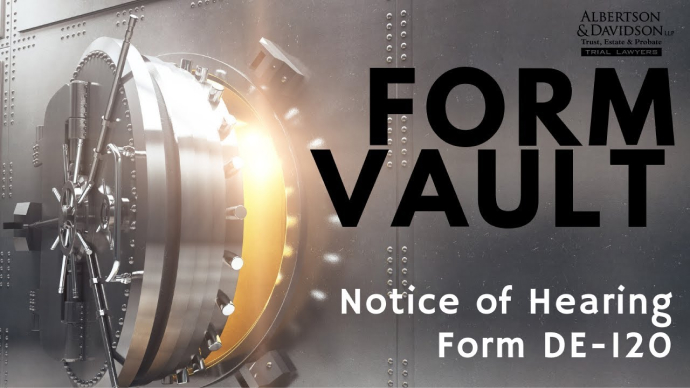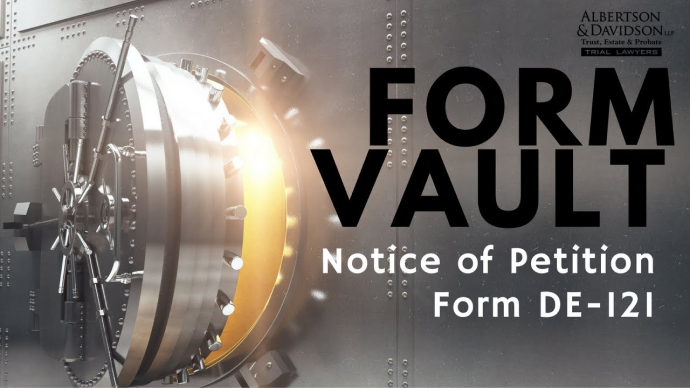Video Transcript
The following is an unedited, verbatim transcript of our video. It is not intended to be a stand-alone article.
This is Keith Davidson at Albertson & Davidson. Today, I’m going over the case management form, and that’s form number CM-110. The case management form is used typically in civil lawsuits, and it’s a form that you submit to the court before going to your case management conference. And the form is used to try and update the court on the status of the case, what’s been happening, what’s still has yet to happen. And it also is an opportunity for the attorneys to talk to each other because they have to do a meet and confer before submitting the form and seeing if there’s anything that they can work out.
So we start off the process by simply going to the Judicial Council form website, and I just type it into Google, and you can go there, and this time around, we are going to be using civil forms, or rather case management forms. There’s not too many of them but we’re going to be using the case management statement.
CM-110
Now, as with all the other forms in our form vault series, you’re going to start off by putting either your information or your attorney information up top here. So, we’re going to fill out the name and number, and the name of our firm, address, all that good stuff – was it going to go up in the top. And don’t forget to put your phone number so that the court can get ahold of you if they need to. You’re going to definitely want to include your email address and your attorney’s name. So we’re going to go back to representing our fictional client Nancy Smith. And this is where you’re going to put in the county. So whatever county you’re appearing in, you can put in the county of the court. You’re going to put in the street address, the mailing address, the city, and the branch name. And you can usually find all of that information by going to the court’s website and filling that in. Now this is a civil form. So this is normally in a case where you have plaintiff versus defendant. So, where we bring these cases a lot is financial elder abuse. So we might have a financial elder abuse claim and it’ll be in civil court and we have to do one of these forms. So let’s say we have Nancy Smith and let’s say she’s going over and she is suing somebody for financial elder abuse, and we’ll put a fictional defendant here in the place. So once you have the name of your petitioner or plaintiff, and the name of your defendant or respondent, now you can get started on the rest of the form. You have to tell the court whether this is a limited or unlimited case – that just means that the amount that’s being sued for is alleged to be in excess of 25,000.00 dollars. You’ll, of course, fill in your case number if you have one. You should have one by now because you should have a pending lawsuit, so you’ll fill that in. And then you’ll have to put in the date, time, department, division, and room number where your case management conference is scheduled to be held. Some courts don’t have divisions and room numbers, some courts do. Whatever applies to you, you fill that in here. And then you put in the address of the court if it’s different from the address that you put above. Usually, it’s the same. You can also tell the court if you intend to appear by telephone and you can put the name there.
Submitting as Joint or Separate Parties
So now, we get started on what this form is all about. We start off with the parties, so party or parties. The statement is submitted, and you can either submit these forms separately – so Nancy Smith and Robert Johnson can either submit their own form, or you can do one joint form. It’s not very common and in my experience that people do joint forms but you can and it does save some time if the parties are willing to file a joint form. You then have to list when the complaint was filed, and if there’s a cross-complaint, you would list when that was filed as well. That next section is dealing with service. The court wants to know if all parties named and then complaint have been served. The court really cannot exercise jurisdiction over your lawsuit until all the parties are properly served. So the court wants to know, do we have a service issue still or has that been taken care of. So you can either say that everybody has been served which hopefully they have been. Or if not, you can specify who has or has not been served in these other boxes. And then the court wants a description of the case. So in our case, Nancy Smith probably filed a complaint for financial elder abuse, and they want a very brief description of what this case is about. They don’t want to know all your facts and evidence. Remember, this form is just for case management. It’s not to decide anything on your case, it’s just to get an idea or a flavor of what we’re dealing with here. So perhaps we’re filing a financial elder abuse claim based on undue influence against Robert Johnson, where he created an alleged trust that transferred some amount of money, so we’ll say over 5 million to himself. So that’s kind of just a very brief description of what we’re dealing with here. So that’s the type of case we’re dealing with. And then on B, you can actually provide a brief statement of the case. Again, you just want to be very brief, you can attach an attachment if you want to, and sometimes that’s a good idea more often than not it’s not a good idea because you might just describe too much. The court really just needs a brief description of what they’re dealing with.
Jury or Non-Jury Trial
Next, we’re going to say do you want a Jury trial or is this a non-jury trial and our financial elder abuse actions were almost always asking for a jury trial, and if there’s more than one party, provide the name of each party requesting a jury trial. They want to know who’s requesting the jury trial because that person needs to pay jury fees. So, we’re going to say we do want a trial, we almost always do want a trial on these types of cases.
Estimation of Trial Date
Next, the court want to know has a trial date been set, if so, what is it, if not, then you would say no trial has been set. But they want to know this case will be ready for trial within 12 months of the date of filing of the complaint, if not, explain. They want to know why is it not ready to go. Really, under the court rules, the court tries to get all civil cases to trial within 12 months that doesn’t always happen, but that’s the goal. And so, if you’re not going to be ready within 12 months, the court wants to know why. The court also wants to know what is your estimate of the length of trial, and you have to be careful with this because there are a lot of courts and a lot of judges who are going to hold your feet to the fire on your trial estimate, come time of trial. So obviously, a lot of times, lawyers will overestimate just to be on the safe side. So you might think it’s a five-day trial and you might say, 7 to 10 days, just to be on the safe side. You do want to be accurate though, so you don’t want to say it’s going to be a 30-day trial when all you need is 3 days. If it’s a short cause matter, you can list it in hours and you can specify how many hours you think you’re going to need of the court’s time. A lot of time, it does take more time than you think to get witness testimony on the stand, but you still want to give somewhat of an accurate estimate. If you don’t know how to give an estimate for the length of trial, then you really need to ask somebody who’s experienced with doing trials to give you some input on that. That way you’ll have at least somewhat of a reasonable estimate. You don’t want to just guess and you don’t want to just be kind of out there, you don’t want to say 1 day of trial when you really need 5. You don’t know want to say 10 days of trial when you only need 2. You need to be a little bit reasonable about it.
The court also wants to know who the trial counsel is going to be because there’s decisions that need to be made about the timing of the trial, the calendaring of the trial, how things are going to go. And if the attorney appearing at the case management conference is different from the attorney who’s going to try the case come time at trial, that can cause problems for the court because they may not have the person they need in front of them to work on calendar dates. So the court wants to know who’s going to try this case and so you’d fill that out.
Giving the Court Specifics
Number 9 is preference, there are some sections under the code where a party might have preference due to things such as age or illness, so you should look at that and see if you do have a preference, you can check that box and you can specify why you have preference. Number 10 is a big one, the court always wants to know what attempts have you made to try and settle this case before trial, and that’s what alternative dispute resolution means. It refers to every attempt to try and settle a case. So, mediation, mandatory settlement conferences, arbitration – that all falls under what we call ADR or alternative dispute resolution. And the court wants to know has the party’s counsel, have the attorneys talked about different forms of ADR, and if you haven’t, you can rest assure that the court will be talking to you about that because the court has a very strong incentive to want you to go and settle your case. So, some cases are subject to arbitration if they’re small, smaller cases. Most cases don’t go to arbitration unless the parties agree to do that which they usually don’t. But you’ll see down here, they ask about all sorts of different types of settlements, so you could do mediation for example which is typically what’s used, and you have to specify if you’re willing to go to mediation. If so, mediation session has not scheduled or it’s scheduled for a certain date, you need to be giving the court some specifics about what you’re doing to try and settle the case. You can also have a settlement conference with the court, you can have a neutral evaluation, this is something that the court implemented about 10 years ago, they used to call them early neutral evaluations where you could go in with either a judge or an attorney and they would give you kind of their two cents of the case kind of early on before you got too involved in it. You can also have non-binding judicial arbitration, binding private arbitration, there’s all these different forms of ADR that you need to consider. And if you just leave this stuff blank and you say “I’m not willing to do anything”, you’re going to get some thoughts from the judge on that. So I would highly recommend that you talk to your client, or if you’re representing yourself, you seriously consider availing yourself of at least one of these forms of mediation if not a couple of them.
Under number 11, the court wants to know is there insurance coverage here, is there insurance carrier, is there reservations of rights, that’s all, insurance stuff. You get into that a lot with personal injury cases, what we do in financial elder abuse, you don’t see that a whole lot, but if you have insurance, you’d fill that out. The court also wants to know is there any jurisdictional issues that they need to be aware of. So for example, is somebody going to file bankruptcy here, because the minute you file bankruptcy, it puts an automatic stay on civil litigation in state court or there are other jurisdictional issues, if so the court wants to know about it and hopefully resolve it before the case goes any further. Number 13 is where the court wants to know are there any related cases that the court should be aware of. Number 14 is bifurcation, that’s where the party might say ya know there’s a piece of this case that we should separate out from the rest of the case and have the court decide first – that’s bifurcation. And the court wants to know is anybody thinking of bringing a motion to bifurcate. Number 15, the court also wants to know are there any other motions they should be aware of? And number 16 is discovery, that’s the big one. So, have the parties complete discovery, if not, then the court wants to know what type of discovery do you intend to do, and when will you complete it? The reason the court wants to know that is that most judges don’t want to set a trial date until discovery is either completed or near completion because it just doesn’t pay to try and set a trial date before that time.
You can see on number 17, economic litigation, that’s for limited civil cases. We don’t typically deal with those type of cases but if you have one then you’ll have to fill out that information. Number 18, are there other issues, is there anything else that you think the court should know about with regard to the case management. Not with regard to the case. Ya know, the court doesn’t want to hear people complain about things, they just want to know is there anything else that the judge needs to know in order to properly manage this case and move it forward to trial. And number 19, this is an important one too, the meet and confer. The California rules of court do require attorneys or parties, if they don’t have attorneys, to meet and confer with the opposing side. So you actually have to talk to them about everything in this form. And then you’ll see on 19B, after this meet and confer process the court wants to know, have the parties agreed on anything. So maybe the parties agreed on mediating or maybe they agreed on admitting certain evidence, come time of trial. Any agreements that have come out of the meet and confer process, the court wants to know about. And then at the bottom, you’ll say if there are any pages attached, and there are various attachments that we’ve talked about, and if so you would put that here. And then, the attorney would just sign this. So if you’re a party without an attorney, then you can just put your own name, put pro per, you can sign it. In my case, since I’m an attorney, I’m representing somebody, I would just put my name, and I would sign it and I would submit this to the court.
Importance of Case Management Statements
The case management statements are really important for courts to receive because it allows the court to properly manage your case and move it forward to trial. Some judges take these statements more seriously than others, but every judge wants to see it, every judge wants it to be filled out fully and completely, and every judge wants to see that some meet and confer has taken place because it makes it easier to move the case forward and ultimately that’s what needs to happen, your case needs to move forward to resolution so that you’re not in court forever. So that’s the California Case Management Statement form CM 110.




